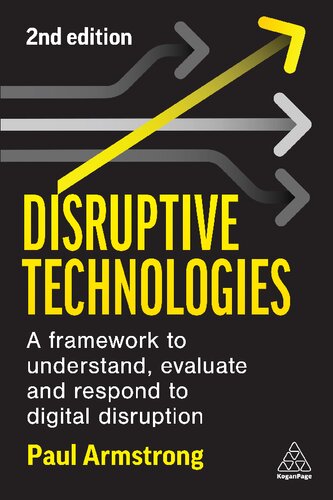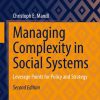Disruptive Technologies : A Framework to Understand, Evaluate and Respond to Digital Disruption 2nd Edition by Paul Armstrong 9781398609211 1398609218
$50.00 Original price was: $50.00.$25.00Current price is: $25.00.
Disruptive Technologies : A Framework to Understand, Evaluate and Respond to Digital Disruption 2nd Edition Paul Armstrong – Ebook Instant Download/Delivery ISBN(s): 9781398609204,9781398609211,9781398609228,139860920X,1398609218,1398609226

Product details:
- ISBN 10:1398609218
- ISBN 13:9781398609211
- Author:Paul Armstrong
Disruptive Technologies
A Framework to Understand, Evaluate and Respond to Digital Disruption
The next two decades will see more waves of technological disruption than the previous fifty. Adaptability and understanding of technological changes are now mission-critical to every business. Disruptive Technologies offers a three-step framework that enables readers to choose how their business responds to technological upheaval rather than being led by changes forced upon them. Showing how to understand a new technology, evaluate the challenge it poses, and finally respond to it, readers will come away secure in the knowledge that they have a workable system with which they can navigate ongoing technological disruption. This second edition features new chapters on the Metaverse and Web 3.0, as well as case studies and discussions of emerging technologies such as NFTs, artificial intelligence, virtual and augmented reality, graphene and 3D/4D printing. If companies do not grasp how developing technologies will impact their operations, supply chains, people and products, they have little hope of weathering the ongoing storm of digital disruption. Disruptive Technologies is your essential guide to creating a stable response to constant technological upheaval.
Table contents:
01 Emerging technologies
Is it emerging or disruptive?
How do disruptive technologies happen?
So what disruptive technologies are going to be big deals?
Conclusion
02 Disruptive and emerging technology: the brutal truth
What’s the problem here?
It doesn’t have to cost the earth
Small is beautiful
Commitment is key to success
It starts with you
What is bad technology?
So are we doomed to a world with good technologies but bad people?
TBD is the solution
03 The forecasting fallacy
Forecasting is hard but you can make it easier
What matters can’t be forecast and what can be forecast doesn’t matter
So how can you make better predictions and forecasts?
Great, so what’s the problem?
Why don’t people change?
Dedication is a hard thing to create and maintain
So what do I do? I’m not a mindreader…
What happens if change is poorly thought out?
The right tools can make people change (or see change) easier
Conclusion: innovation needs a flexible framework
04 The TBD framework: an introduction
The future needs to be agile
The right mindset is key
How to toughen your optimism
The forecast is still cloudy, fast and changeable
The origins of TBD
Why two versions?
What ‘simple’ TBD is set up to do
The ‘simple’ TBD framework
Conclusion
05 Complex TBD
Why are two versions of TBD needed?
What is TBD+?
When do you use TBD+?
Before you start, a word on failure
The TBD+ process
Conclusion
06 How to get sign-off
Why people resist ideas and solutions
Understanding risk and why it isn’t a dirty word
Bias is everywhere and nowhere
Outsiders are often seen or needed to create movement
Selling power… painfully
‘That’s expensive’
Conclusion
07 Open business and innovation
What is open business?
Open business does not mean (or require) Holacracy
So how open does an open business have to be?
Why is being open such a big deal?
A halfway house is possible… but risky
So if open is hard and halfway isn’t great – where do I start?
For effective change, you need to create some disharmony
Sometimes you just need one thing… someone else
Conclusion
08 What to look out for
Expect the unexpected – they will come
Run away if you hear senior executives say ‘it won’t happen to us’
Remember: fearing the iceberg is wrong
What you should do and what you shouldn’t do
Expect that things will also go wrong
An innovation toolkit
Conclusion
09 Dis-innovation
Why ‘think different’ probably won’t work for you but thinking differently will
How you fix a bench says a lot about you and your company
Complacency is the killer, commitment is key
Your approach to any change has to be tailored
Thinking differently requires other people, not just you
Conclusion
10 Web 3.0: The opportunities… and issues
Why is Web3 disruptive?
A quick Web3 glossary
How people are using Web3 today
How DAOs will change the way businesses form and function
How will people use Web3 in the future?
What’s the future for Web3?
Web5 (yes, five) is already here
11 The metaverse – a truly disruptive technology
Where are we now?
Why is the metaverse disruptive?
Pros and cons of the metaverse
Why Meta is (and isn’t) driving the metaverse narrative
How should brands enter the metaverse?
What comes after the multiverse?
12 Disruption and newer generations
Why saying ‘Millennial’ is not helping you or your business
Challenge your myths about Millennials
Why are people who were born between 1980 and 2000 so important?
Your business needs EQ not IQ – form a Millennial mindset
Do not dismiss the desire for meaning and meaningful work
Conclusion
13 The future of TBD and disruptive technologies
TBD is a framework – you are what makes it work
Why TBD goes with you through life
The future should not be feared
The future of TBD
People also search:
disruptive technologies : a framework to understand
disruptive technologies definition
disruptive technologies examples
disruptive technology quizlet
disruption framework
You may also like…
Education Studies & Teaching - School Education & Teaching
Uncategorized
Education Studies & Teaching - School Education & Teaching
Engineering - Social & Cultural Aspects of Technology
Computers - Security
Relationships & Lifestyle - Pregnancy & Childcare












